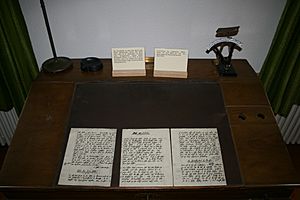Safenwil facts for kids
Quick facts for kids
Safenwil
|
||
|---|---|---|
|
||
| Country | Switzerland | |
| Canton | Aargau | |
| District | Zofingen | |
| Area | ||
| • Total | 5.99 km2 (2.31 sq mi) | |
| Elevation | 483 m (1,585 ft) | |
| Population
(Dec 2020 )
|
||
| • Total | 4,107 | |
| • Density | 685.6/km2 (1,775.8/sq mi) | |
| Postal code |
5745
|
|
| Surrounded by | Gretzenbach (SO), Kölliken, Oftringen, Uerkheim, Walterswil (SO), Zofingen | |
Safenwil is a municipality in the district of Zofingen in the canton of Aargau in Switzerland.
History
The first settlement in the area was a Roman era estate on a mule track from the Wigger valley toward Vindonissa. This was followed by a small Alamanni camp or settlement. The Eberkopf (German: Boar's Head) rock carvings date back to 893 AD, though the modern village of Safenwil is first mentioned in 924 as Sabenewilare. In the 13th century the village was under the rule Belp. In the 14th century the Ifenthal family ruled over the village from Scherenberg castle. With the conquest of the Aargau in 1415, the village came under the authority of Bern. Under Bernese rule, Safenwil was located in the Lenzburg District. In 1415 Bern took over the high court rights in the village. The low court right was held by Gösgen in Solothurn after 1458. In 1665 this court also went to Bern. In 1803 it became part of the newly formed Canton of Aargau and was assigned to the Zofingen district. School houses were built in Safenwil in 1730, 1829–30, 1908, 1969 and 1999.
In 1304, Zofingen monastery built the St. Ulrich's Chapel in Safenwil. During the Protestant Reformation, Bern destroyed the chapel. Before the Reformation, Safenwil was part of the Gretzenbach parish. Between 1528-1616 it was in the Zofingen parish, and after 1616 it was part of the Kölliken parish. In 1865 it became an independent parish, and built its own church in 1866-67.
Around 1770 Bern built the regional road from Bern to Zurich through the village. Then, in 1877, Swiss Federal Railways included it on the Aarau-Zofingen line. Since 1967, the A1 motorway cuts through the town. The good transportation links allowed the town to grow. Around 1820 the first factory, a weaving and dyeing factory, opened in Safenwil. The Hüssy factory remained open for over a century, closing in 1934. In 1897 the Hochuli knitting factory opened near the train station. In the 19th and 20th centuries several other factories opened, while other residents commuted to factories in Zofingen and Schönenwerd. In 1920, 14% of the jobs were in agriculture, while 75% were in industry. By 2005 most of the heavy industry had moved out and only 19% worked in industry while 77% worked in the services sector. In 1951, the car import company Emil Frey moved into the municipality. This company employs approximately 230 workers and shapes the local labor market and the village.
Geography
Safenwil has an area, as of 2009[update], of 5.99 square kilometers (2.31 sq mi). Of this area, 1.66 km2 (0.64 sq mi) or 27.7% is used for agricultural purposes, while 2.75 km2 (1.06 sq mi) or 45.9% is forested. Of the rest of the land, 1.61 km2 (0.62 sq mi) or 26.9% is settled (buildings or roads) and 0.01 km2 (2.5 acres) or 0.2% is unproductive land.
Of the built-up area, industrial buildings made up 5.0% of the total area while housing and buildings made up 13.0% and transportation infrastructure made up 7.2%. Out of the forested land area, all of it is covered with heavy forests. Of the agricultural land, 12.2% is used for growing crops and 14.7% is pastures.
The municipality is located in the Zofingen district, between the lower Wigger and Suhre river valleys. Its northern border is shared with the Canton of Solothurn.
See also
 In Spanish: Safenwil para niños
In Spanish: Safenwil para niños




